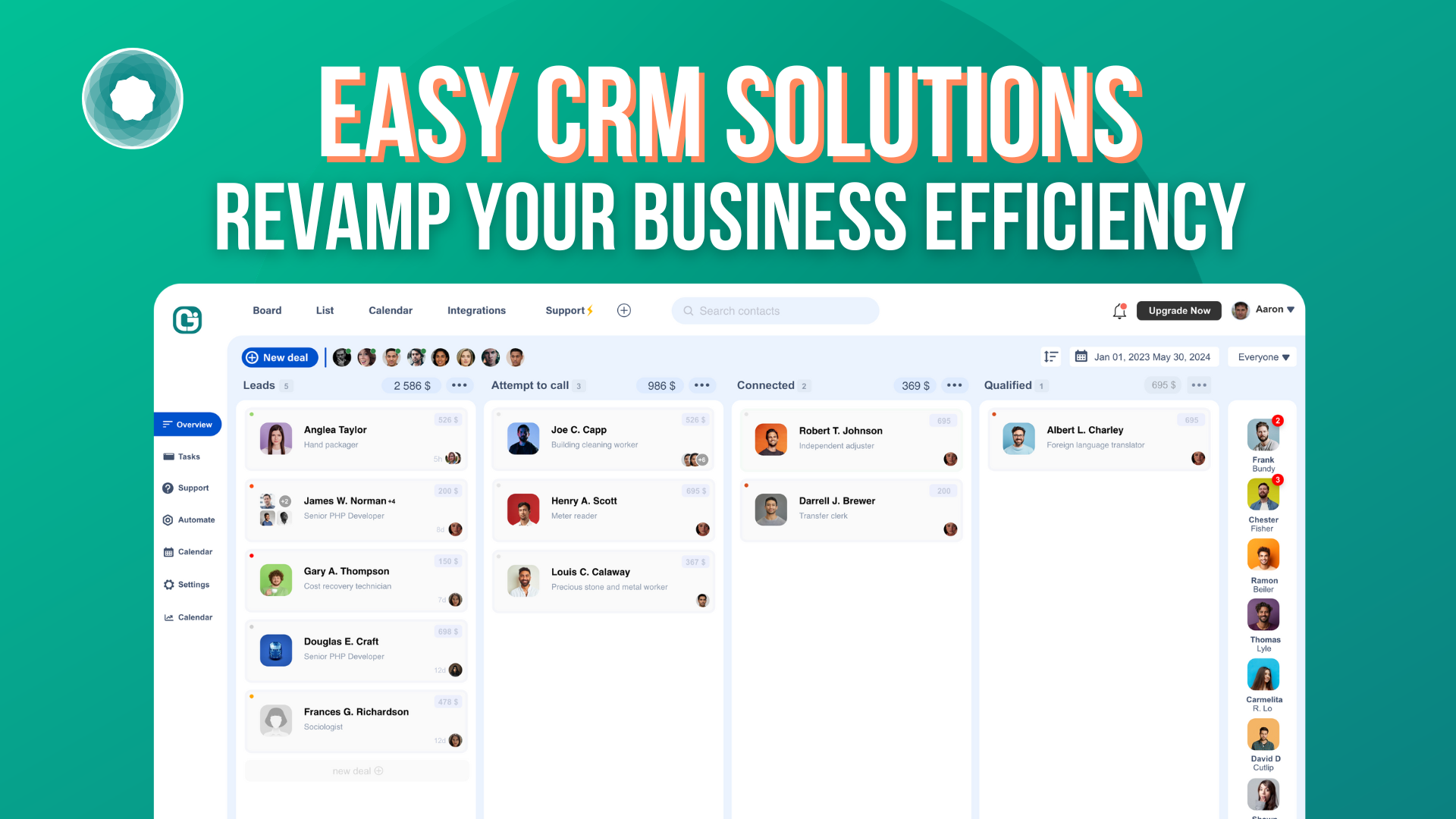
CRM Marketing Trends 2025: Navigating the Future of Customer Relationships
The world of customer relationship management (CRM) is constantly evolving. What worked yesterday might not work tomorrow. As we approach 2025, understanding the emerging CRM marketing trends is crucial for businesses aiming to thrive in an increasingly competitive landscape. This article delves into the key trends shaping the future of CRM marketing, offering insights and strategies to help you stay ahead of the curve. Prepare to explore how these trends will impact your customer interactions, marketing strategies, and overall business success.
The Rise of Hyper-Personalization
Personalization has been a buzzword for a while, but in 2025, we’re moving beyond basic segmentation. Hyper-personalization is the future. It means tailoring every interaction to the individual customer, based on their unique preferences, behaviors, and needs. This goes beyond simply using a customer’s name in an email. It involves:
- Real-time Data Analysis: Leveraging advanced analytics and AI to understand customer behavior in real-time.
- Predictive Personalization: Anticipating customer needs and proactively offering relevant products or services.
- Dynamic Content: Delivering content that changes based on the customer’s profile and current context.
The key to hyper-personalization is data. Businesses need to collect and analyze vast amounts of data to understand their customers. This includes data from various sources, such as website activity, social media interactions, purchase history, and customer service interactions. However, it’s not just about collecting data; it’s about using it effectively. This means investing in the right tools and technologies to analyze the data and derive actionable insights. Furthermore, businesses must be transparent about how they collect and use customer data, ensuring compliance with privacy regulations.
Strategies for Implementing Hyper-Personalization
Implementing hyper-personalization requires a strategic approach. Here are some key strategies:
- Invest in a Robust CRM System: Choose a CRM platform that can handle large volumes of data and integrate with other systems.
- Embrace AI and Machine Learning: Utilize AI-powered tools for data analysis, predictive modeling, and content personalization.
- Segment Your Audience Effectively: Go beyond basic demographics and create detailed customer profiles based on behavior and preferences.
- Personalize Across All Channels: Ensure a consistent and personalized experience across all touchpoints, from email and website to social media and in-app messaging.
- Test and Optimize: Continuously test and optimize your personalization efforts to improve results.
AI-Powered CRM: Automation and Insights
Artificial intelligence (AI) is no longer a futuristic concept; it’s a present-day reality in CRM. AI-powered CRM systems are transforming how businesses interact with their customers. AI is used for several purposes:
- Automating Tasks: Automating repetitive tasks, such as data entry, email responses, and lead scoring, freeing up human agents to focus on more complex interactions.
- Providing Insights: Analyzing vast amounts of data to identify trends, predict customer behavior, and provide actionable insights.
- Enhancing Customer Service: Powering chatbots and virtual assistants to provide instant support and resolve customer inquiries.
The benefits of AI-powered CRM are numerous. It can improve efficiency, reduce costs, enhance customer satisfaction, and drive revenue growth. However, implementing AI in CRM requires careful planning and execution. Businesses need to choose the right AI tools and integrate them seamlessly into their existing systems. They also need to train their employees to use these tools effectively. Furthermore, it’s important to monitor the performance of AI-powered systems and make adjustments as needed.
Key Applications of AI in CRM
Here are some of the key applications of AI in CRM:
- Chatbots: Providing instant customer support and answering frequently asked questions.
- Predictive Lead Scoring: Identifying the leads most likely to convert.
- Sentiment Analysis: Analyzing customer feedback to understand their feelings and emotions.
- Personalized Recommendations: Recommending products or services based on customer preferences and behavior.
- Automated Email Marketing: Sending personalized emails based on customer actions and preferences.
The Omnichannel Experience: Seamless Customer Journeys
Customers interact with businesses across multiple channels, including websites, social media, email, phone, and in-person interactions. An omnichannel experience provides a seamless and integrated experience across all these channels. In 2025, customers expect businesses to know their preferences and history, regardless of the channel they’re using. This means:
- Consistent Branding: Maintaining a consistent brand identity and messaging across all channels.
- Data Synchronization: Ensuring that customer data is synchronized across all channels.
- Personalized Interactions: Delivering personalized interactions based on the customer’s history and preferences, regardless of the channel.
Creating an effective omnichannel experience requires a customer-centric approach. Businesses need to understand their customers’ needs and preferences and design their channels accordingly. This involves investing in the right technologies and training employees to provide a consistent and personalized experience across all channels. Furthermore, businesses must continuously monitor and optimize their omnichannel strategy to ensure it meets the evolving needs of their customers.
Building a Successful Omnichannel Strategy
Here are some key steps to building a successful omnichannel strategy:
- Map the Customer Journey: Understand how customers interact with your business across different channels.
- Choose the Right Channels: Select the channels that are most relevant to your target audience.
- Integrate Your Data: Ensure that customer data is synchronized across all channels.
- Personalize the Experience: Deliver personalized interactions based on the customer’s history and preferences.
- Measure and Optimize: Continuously monitor and optimize your omnichannel strategy to improve results.
Data Privacy and Security: Building Trust
With increasing data breaches and privacy concerns, data privacy and security will be paramount in 2025. Customers are becoming more aware of how their data is used and are demanding greater transparency and control. Businesses must prioritize data privacy and security to build trust and maintain customer loyalty. This includes:
- Complying with Regulations: Adhering to data privacy regulations, such as GDPR and CCPA.
- Protecting Customer Data: Implementing robust security measures to protect customer data from breaches.
- Being Transparent: Being transparent about how customer data is collected, used, and protected.
- Providing Control: Giving customers control over their data, including the ability to access, modify, and delete it.
Data privacy and security are not just legal requirements; they are also essential for building trust with customers. Businesses that prioritize data privacy and security are more likely to attract and retain customers. They also build a positive reputation and avoid costly fines and legal issues. Investing in data privacy and security is an investment in your business’s long-term success.
Best Practices for Data Privacy and Security
Here are some best practices for data privacy and security:
- Implement Strong Security Measures: Use encryption, firewalls, and other security measures to protect customer data.
- Comply with Data Privacy Regulations: Ensure compliance with relevant data privacy regulations.
- Be Transparent About Data Practices: Clearly communicate how customer data is collected, used, and protected.
- Provide Customers with Control: Give customers control over their data, including the ability to access, modify, and delete it.
- Train Employees on Data Privacy and Security: Educate employees on data privacy and security best practices.
The Rise of Conversational CRM
Conversational CRM is transforming how businesses interact with their customers. It involves using chatbots, messaging apps, and other conversational interfaces to provide instant support, answer questions, and drive sales. In 2025, conversational CRM will become even more sophisticated, with AI-powered chatbots capable of handling complex customer inquiries and providing personalized recommendations.
Conversational CRM offers several benefits, including:
- 24/7 Availability: Providing instant support and answering questions around the clock.
- Personalized Interactions: Delivering personalized interactions based on the customer’s history and preferences.
- Improved Efficiency: Automating tasks and freeing up human agents to focus on more complex interactions.
- Increased Sales: Driving sales by providing personalized recommendations and guiding customers through the sales process.
Implementing conversational CRM requires a strategic approach. Businesses need to choose the right conversational platforms, such as chatbots and messaging apps. They also need to design conversational flows that are easy to use and provide a positive customer experience. Furthermore, businesses must continuously monitor and optimize their conversational CRM strategy to ensure it meets the evolving needs of their customers.
Key Elements of a Successful Conversational CRM Strategy
Here are some key elements of a successful conversational CRM strategy:
- Choose the Right Platforms: Select the conversational platforms that are most relevant to your target audience.
- Design User-Friendly Flows: Create conversational flows that are easy to use and provide a positive customer experience.
- Integrate with Your CRM System: Integrate your conversational platforms with your CRM system to access customer data and personalize interactions.
- Train Your Chatbots: Train your chatbots to handle complex customer inquiries and provide personalized recommendations.
- Monitor and Optimize: Continuously monitor and optimize your conversational CRM strategy to improve results.
CRM and the Metaverse: New Opportunities
The metaverse is a rapidly evolving digital world that offers new opportunities for businesses to connect with their customers. In 2025, CRM will integrate with the metaverse, allowing businesses to provide immersive and interactive customer experiences. This could involve:
- Virtual Stores: Creating virtual stores where customers can browse products and interact with sales representatives.
- Virtual Events: Hosting virtual events, such as product launches and webinars, in the metaverse.
- Personalized Avatars: Allowing customers to create personalized avatars that represent them in the metaverse.
The metaverse offers exciting possibilities for CRM. Businesses can use the metaverse to create immersive customer experiences, build brand loyalty, and drive sales. However, it’s important to approach the metaverse strategically. Businesses need to understand their target audience and create experiences that are relevant and engaging. They also need to invest in the right technologies and platforms to create a seamless and immersive experience.
Exploring CRM Applications in the Metaverse
Here are some ways CRM can be applied within the metaverse:
- Virtual Customer Service: Providing customer support through virtual assistants and interactive guides within a metaverse environment.
- Immersive Product Demonstrations: Allowing customers to experience products in a realistic and interactive way within the metaverse.
- Personalized Virtual Spaces: Creating personalized virtual spaces for customers to interact with brands and other customers.
- Data-Driven Insights: Gathering data on customer behavior within the metaverse to personalize experiences and improve marketing strategies.
The Role of Employee Experience in CRM
Happy and engaged employees are essential for delivering excellent customer experiences. In 2025, businesses will recognize the importance of employee experience (EX) in CRM. This means providing employees with the tools, training, and support they need to succeed. It also means creating a positive work environment where employees feel valued and appreciated.
Investing in employee experience can lead to several benefits, including:
- Improved Customer Satisfaction: Happy and engaged employees are more likely to provide excellent customer service.
- Increased Employee Retention: Creating a positive work environment can reduce employee turnover.
- Enhanced Productivity: Providing employees with the tools and training they need can improve productivity.
- Better Innovation: Encouraging employee feedback and ideas can drive innovation.
Prioritizing employee experience requires a holistic approach. Businesses need to invest in employee training, provide competitive compensation and benefits, and create a positive work environment. They also need to listen to employee feedback and make adjustments as needed. Furthermore, businesses should empower employees with the right tools and technologies to deliver exceptional customer experiences.
Strategies for Enhancing Employee Experience in CRM
Here are some strategies for enhancing employee experience in CRM:
- Provide Comprehensive Training: Equip employees with the skills and knowledge they need to succeed.
- Offer Competitive Compensation and Benefits: Attract and retain top talent by offering competitive packages.
- Create a Positive Work Environment: Foster a culture of collaboration, respect, and appreciation.
- Empower Employees with the Right Tools: Provide employees with the tools and technologies they need to deliver exceptional customer experiences.
- Solicit and Act on Employee Feedback: Regularly gather feedback from employees and use it to improve the work environment.
The Integration of CRM with Other Technologies
CRM systems are no longer isolated islands. In 2025, we’ll see even greater integration of CRM with other technologies, such as:
- Marketing Automation: Seamlessly integrating CRM with marketing automation platforms to personalize campaigns and track results.
- Sales Force Automation: Connecting CRM with sales force automation tools to streamline sales processes and improve sales productivity.
- Customer Service Platforms: Integrating CRM with customer service platforms to provide a unified view of the customer and improve customer support.
- Business Intelligence Tools: Connecting CRM with business intelligence tools to gain deeper insights into customer behavior and business performance.
This integration will enable businesses to create a more holistic view of their customers and provide a more personalized and seamless experience. It will also improve efficiency, reduce costs, and drive revenue growth. The key to successful integration is choosing the right technologies and ensuring that they can communicate effectively with each other. Businesses must also have a clear understanding of their business goals and how these integrations can help them achieve those goals.
Benefits of CRM Integration
Here are some key benefits of integrating CRM with other technologies:
- Improved Data Visibility: Gain a more complete view of the customer by integrating data from various sources.
- Enhanced Efficiency: Automate tasks and streamline processes by integrating different systems.
- Increased Personalization: Deliver more personalized experiences by leveraging data from various channels.
- Better Decision-Making: Make more informed decisions by analyzing data from integrated systems.
- Increased Revenue: Drive revenue growth by improving sales and marketing effectiveness.
CRM Marketing Trends 2025: A Summary
As we move towards 2025, the CRM marketing landscape is poised for significant transformation. The trends discussed above – hyper-personalization, AI-powered CRM, omnichannel experiences, data privacy, conversational CRM, metaverse integration, employee experience, and technology integration – are not just isolated developments. Instead, they are interconnected elements that will collectively redefine how businesses interact with their customers.
To succeed in this evolving environment, businesses must embrace these trends and adapt their strategies accordingly. This means investing in the right technologies, training employees, and prioritizing customer experience. Those who proactively embrace these changes will be well-positioned to build stronger customer relationships, drive revenue growth, and thrive in the future.
The key takeaway is that CRM marketing is no longer just about managing customer data; it’s about building meaningful relationships. By embracing these trends, businesses can create lasting connections with their customers and build a loyal customer base that fuels long-term success.
Conclusion
The future of CRM marketing is exciting and dynamic. By understanding and embracing the trends discussed in this article, businesses can prepare for 2025 and beyond. This involves a commitment to data-driven decision-making, a focus on customer experience, and a willingness to adapt to the ever-changing landscape. The businesses that embrace these changes will be the ones that thrive. The journey to 2025 and beyond is a journey of constant learning, adaptation, and innovation. Success in the world of CRM marketing will depend on a business’s ability to embrace change and put the customer at the center of everything they do.


